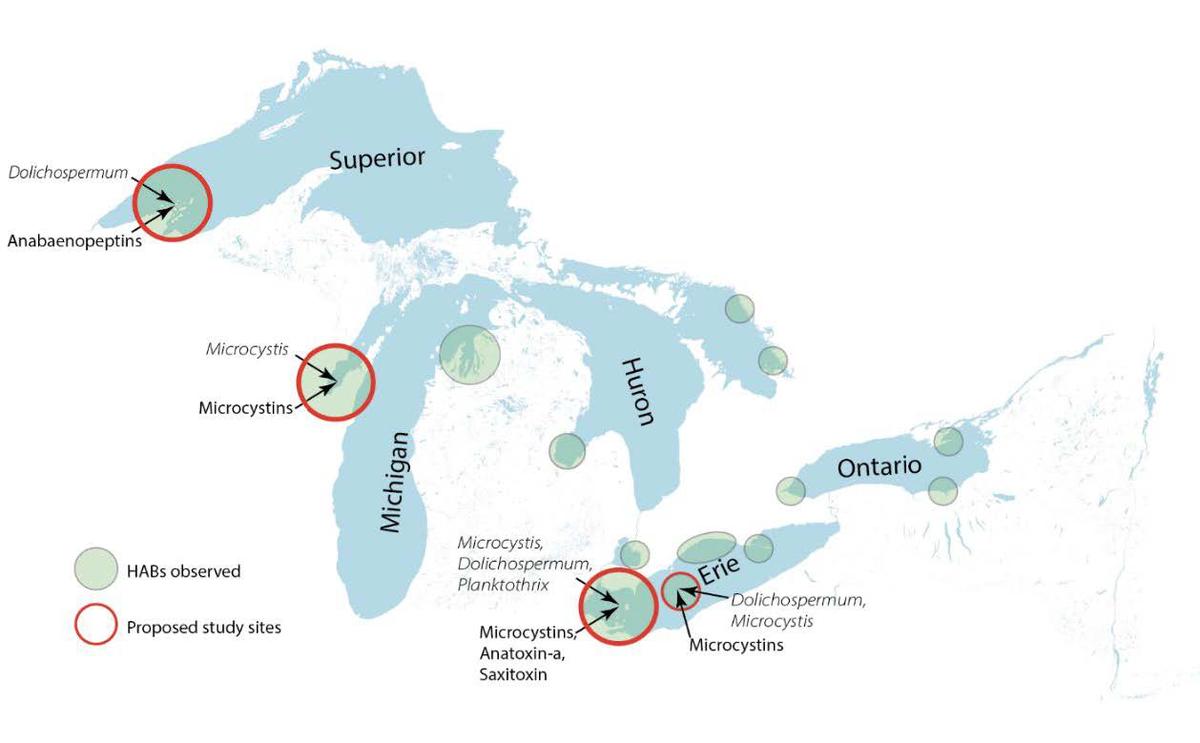
Locations of regularly appearing CHABs in the Great lakes with proposed sampling sites indicated in red. Dominant bloom-forming taxa are indicated for the proposed study sites as well as the most commonly detected cyanobacterial toxins. Graphic credit: Robert Sterner.
Goal: This project seeks to determine the stoichiometric (chemical arithmetic) and climate determinants of diverse Great Lakes cyanobacteria harmful algal blooms (cHABs).
Outcomes: Fundamental to resource stewardship is the critical question of what exactly to manage. Blooms across the Great Lakes are likely not responding to the exact same set of drivers. The outcomes of this project will help moving toward an actionable understanding of what substances need to be controlled most critically.
Project description
Project description
Background: Nutrients and climate warming are the two main factors thought to be responsible for the increasing occurrence of cyanobacterial harmful algal blooms (CHABs) worldwide. The Great Lakes provide a host of ecosystem services to many millions of people but are under threat from multiple stressors, including CHABs, which occur in all five Great lakes even though there is a wide range of biogeochemical and temperature environments across these globally important systems. To-date CHABs in the Great Lakes have been investigated lake-by-lake or even river-by-river, with studies in each location tuned to local perspectives and framed with different research questions.
The wide geographic spread of CHABs in the Great Lakes has hindered synthetic, comparative work, making it difficult to generalize findings. Consequently, little is known about how results from one location can be applied elsewhere. This project brings together three cross-disciplinary teams with deep experience in ecological stoichiometry, CHABs, toxins, and genomics who will use a common experimental template to understand how patterns of Nitrogen (N) vs. Phosphorus (P) limitation vary across the Great Lakes, and how those in turn are influenced by temperature.
The project team will investigate how separate forms of N affect bloom dynamics. Impact of N, P and temperature on community dynamics in bloom formation will be resolved using multiple lines of evidence including algal pigments, microscopy, advanced chemistry targeting cyanotoxins and other secondary metabolite and molecular tools such as qPCR and ‘omics targeted at microbial community composition, cyanotoxin gene presence and community gene expression. Key parameters needed to understand N vs. P balance in the Great Lakes (urea concentration and N fixation) will be added to ongoing monitoring. This would be a first highly integrated experimental study of CHABs across diverse Great Lakes environments.
Funding
Support for this project is provided by Minnesota Sea Grant’s 2022-2024 Biennial Request for Proposal program. Every two years MNSG awards approximately $2 million in research grants through a rigorous, competitive, peer-reviewed process. Researchers based in Minnesota, who are not federal employees, are invited to apply. Grant awards average about $45,000 per year for two years, plus a graduate research associate whose cost does not count against the project budget.
Outreach plan
The project team will share their research findings via:
- Minnesota Sea Grant Extension Program Leader Amy Schrank and the MNSG extension educators.
- Great Lakes Sea Grant Harmful Algal Bloom listserv.
- Participation in the biennial Great Lakes Sea Grant Network Meeting.
- Contributing content to Ohio Sea Grant's TwineLine publication.
- Wisconsin Sea Grant's Green Bay city partners.
Project team
Project Manager:
Robert Sterner
email@d.umn.edu
Professor
Large Lakes Observatory
University of Minnesota Duluth
Co-Investigator(s):
Todd Miller
University of Wisconsin Milwaukee
George S. Bullerjahn
Bowling Green State University
Why Sea Grant?
This project supports Minnesota Sea Grant's Healthy Coastal Ecosystems focus area. The United States manages millions of square miles of coastal ecosystems that support a variety of recreational, commercial, and subsistence activities. Sea Grant helps residents, natural resource managers, business, and state and local governments protect and restore healthy coastal habitats for continued ecosystem and public well-being.
Lead scientist(s)
Robert Sterner
stern007@d.umn.edu
Professor of Biology
Director, Large Lakes Observatory
University of Minnesota Duluth